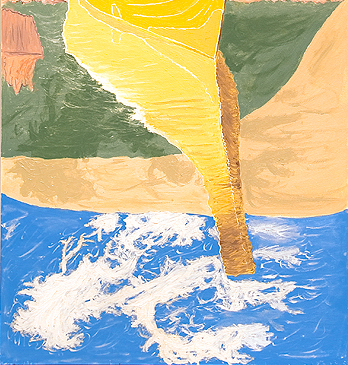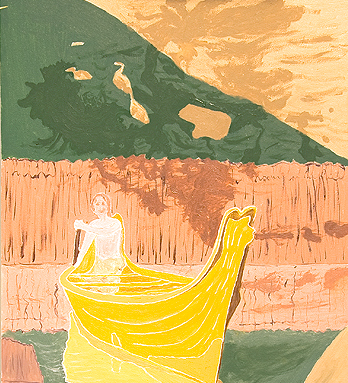I had painted the yellow canoe a few weeks ago when the tasks ahead of me looked challenging. I felt that picture gave me energy and courage to face a challenging time in Germany.
In Germany, I was fortunate to get Karl Zipser’s critique on my painting, not the real one but its reproduction on A&P. Karl liked its bottom aspect shown below.
 (the sky is not quite as aggressively blue as shown here).
(the sky is not quite as aggressively blue as shown here).
The boat in the top aspect of the painting, seen below, Karl said, expresses the problem of painting realistically from a photograph. The boat is too real compared to the sketchy background that is supposed to represent reeds with a dune. Karl also disliked the smiley impression on ‘my’ face.
A final lesson was not to make the picture too tall. A picture has to be viewable on a small laptop. Looking at the canoe painting, as I scrolled it up and down on a tiny monitor of an Acer laptop at an internet café, Karl did not immediately grasped about the cloud images. Namely, that on the top, a cloud throws a dark shadow on the dune which then is reflected as lighter dark shadow into the water and finally, the white cloud and blue sky directly reflecting into the bottom aspect of the picture.
Karl and I then decided that I could improve the picture by filling in the background in the top aspect thereby removing the boat and then painting the boat again, less photographically accurate.
What sounded like a good idea in Germany, no longer felt right when I came home and looked at the actual painting. Looking at the yellow boat makes me feel good, gives me strength! As an aside, what had seemed a challenging time ahead on April 24th turned out to be significantly more challenging both in Germany and here in Michigan. To accomplish all the tasks that have accumulated requires that I clone myself, three copies and the original should be enough.
My emotions tell me to keep the current yellow canoe for feeling good. For the moment, I will also keep the silly smiley face.
Currently, I plan to fix the background – the reeds and dune – rather than the canoe so that all three will begin to harmonize in the top aspect of the picture.
I already followed one piece of advice that Karl gave me. I painted the 3/4 inch cradle of the Ampersand board dark green, not in oil but with viridian acrylic. Karl said that a dark frame will help me to paint the entire spectrum from white to black.
Having documented Karl’s critique that I am interpreting creatively, I now will return to my day job.


I don’t know, Birgit, I liked the painting exactly the way it was. But I wasn’t reading it as a realistic image. I thought the boat was sitting on top of a yellow cyclone or waterspout. I also enjoyed your mixture of flat and drawn elements, and I liked the muted palette and vertical format. My suggestion is to put the painting up on your wall (did you have that glass of wine yet?), and incorporate Karl’s advice, if you agree with it, into your next painting.
David,
I also like the picture for the features that you mentioned.
So far, I have only painted the cradle of the Ampersand board green which helps. Good idea to look at the picture hanging on the wall for a while.
A weird idea last night concerning a possible modification of my painting was prompted by reading ‘The Shape of Space’ by Jeffrey R. Weeks. I have not made it beyond the third chapter of the book because my brain is still trying to grasp intuitively how to imagine 4-dimensional space. I was fortunate to meet Jeffrey, a freelance mathematician and MacArthur fellow. Feeling that Jeff had an ‘ethereal’ quality, I refered to him as the ‘Angel’ when talking about him to my husband.
Birgit,
I didn’t and don’t think of the boat as particularly realistic, though it’s more so than the background. That’s why I viewed it as more of a dream vision, which fit with the floating impression I mentioned that is due to the obviously identifiable sky being at the bottom of the picture.
I agree with David that you would probably do best to leave this one as is, and possibly try other ideas on the next, perhaps a new version of the same one. I suspect you would learn a lot by repeating even the parts you don’t intend to change. There will inevitably be differences due to technique or altered approach as you go, and having the comparison will help appreciate and those and improve the picture. Anyway, I would be very wary of changing something that you like as is.
I agree w/ Steve. The best way to evolve a body of work is to use each painting to do the things you thought you should have done differently in the one you just finished.
My understanding is that the 4th dimension refers to time (and the 5th to a singing group from the sixties). Is Jeff talking about something else?
Birgit:
Is it me, or is WordPress dumping a lot of comments. Thank goodness I was just into a second sentence when the eraser came out.
For fear of being deleted again allow me to say that there is much wisdom in taking whatever lessons from your first effort and moving on. I am now purging my storage areas to avoid being accursed by my children upon the occasion of my death. Every second thing that I drag out represents a struggle that I had in trying to reconcile a questionable beginning through patchwork expedients. Your beginning is actually quite strong and, yes, hang it and let’s see what the next iteration brings.
Thanks guys
(1) my brain is too polluted with other information to be able to recall much of the content of Jeff’s first three chapters written for the understanding of people at the high school level.
(2) I do understand about letting go and moving on with respect to painting. But in some cases, I do go back and make improvements that I am very happy with.
Must focus on other matters, see you in a bit.
Birgit,
I am going to have to investigate The Shape of Space, since you say it’s written for the understanding of people at the high school level. I might be able to handle it.
I agree wholeheartedly with the comments above, and with great respect etc etc., I disagree with Karl. So I’m glad you are focusing on other matters and letting the painting alone. I like the point on the continuum of abstract—-representational that it shows and wouldn’t want to lose it. The canoe is terrific.